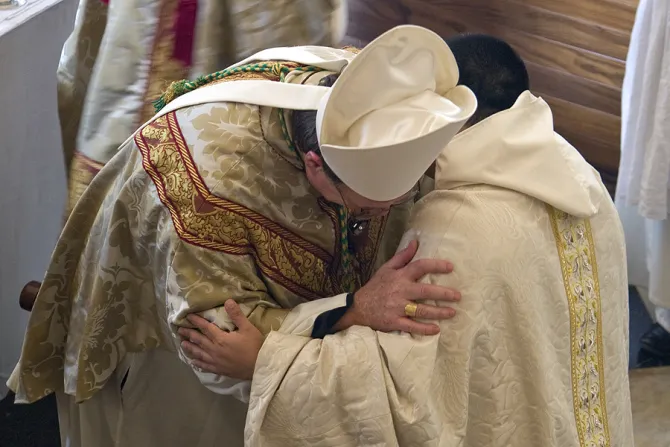ACI Prensa Staff, Apr 18, 2024 / 07:00 am
The director of the Chair of Theology of the Consecrated Life at San Dámaso Ecclesiastical University in Spain, Sister Carolina Blázquez Casado, OSA, explained that the rite of peace at Mass “is not a greeting or friendly gesture.”
The sister explained the meaning of the rite in a video posted by the university, which is under the Archdiocese of Madrid.
The sign of peace, which takes place between the recitation of the Lord’s Prayer and the Fraction (breaking) of the Host, “is a prior step to be able to approach Communion with the body of Christ in a dignified manner,” the Augustinian sister explained.
The sign of peace is exchanged in recollection of the words of Jesus recorded in Matthew 5:23-24, namely: “Therefore, if you bring your gift to the altar, and there recall that your brother has anything against you, leave your gift there at the altar, go first and be reconciled with your brother, and then come and offer your gift.”
Blázquez noted that “Christians, from when they first began to celebrate the Eucharist, had these words of the Lord in their minds and hearts. And that is why the rite of peace has been present since very ancient times in the Eucharistic celebration.”
Consequently, the sign of peace is not a simple polite gesture or a gesture of human love, but rather it expresses “the sincere desire to be reconciled among ourselves, to overcome all divisions between us, to be instruments of peace, to be truly members, one of another, of the one body of Christ.”
The video posted by the San Dámaso Ecclesiastical University is part of a series titled “The Eucharist. Learn More” in which several teachers from the institution explain various aspects of the sacrament.
Abuses of the rite
In 2014, while Cardenal Antonio Cañizares was prefect of the Congregation for Divine Worship and the Discipline of the Sacraments, a letter on the subject titled “The Ritual Meaning of the Gift of Peace in the Mass” was approved and confirmed by Pope Francis.
The letter addresses problems arising from some “exaggerated expressions” of the rite of peace, which led Pope Benedict XVI to consult the bishops’ conferences on the possibility of the rite being modified or eliminated from the Roman Missal.
In the end, it was decided to keep it in place while offering a series of “practical provisions to better explain the content of the exchange of peace and to moderate excessive expressions that give rise to disarray in the liturgical assembly before Communion.”
The letter emphasized that “if the faithful through their ritual gestures do not appreciate and do not show themselves to be living the authentic meaning of the rite of peace, the Christian concept of peace is weakened and their fruitful participation at the Eucharist is impaired.”
Among the provisions, the letter stated that the rite of peace can be omitted “and sometimes ought to be omitted” if circumstances deem it advisable. The bishops’ conferences should consider, “in those places where familiar and profane gestures of greeting were previously chosen,” replacing them with “other more appropriate gestures.”
Abuses to avoid include “the introduction of a ‘song for peace,’ which is nonexistent in the Roman Missal; the movement of the faithful from their places to exchange the sign of peace; the departure of the priest from the altar in order to offer the sign of peace to some of the faithful” or taking advantage of the occasion “for expressing congratulations, best wishes, or condolences among those present.”
This story was first published by ACI Prensa, CNA’s Spanish-language news partner. It has been translated and adapted by CNA.






